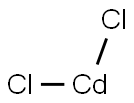Cadmium standard , 0.100ug/gin0.5mol/LHNO3withK+2.2mg/L,Na+23mg/L,Ca2+39mg/L,Mg2+11mg/L,0.5mol/LHNO3 , 7440-43-9
Synonym(s):
Cadmium;Cadmium nitrate solution
CAS NO.:7440-43-9
Empirical Formula: Cd
Molecular Weight: 112.41
MDL number: MFCD00010914
EINECS: 231-152-8
PRODUCT Properties
| Melting point: | 320.9 °C (lit.) |
| Boiling point: | 765 °C (lit.) |
| Density | 8.65 g/mL at 25 °C (lit.) |
| vapor pressure | 1.3 hPa (394 °C) |
| storage temp. | Store below +30°C. |
| solubility | 8.2mg/l insoluble |
| form | wire |
| Specific Gravity | 8.642 |
| color | Silvery white |
| Odor | Odorless |
| PH | 4.2 (20°C in H2O) |
| Flame Color | Brick red |
| Resistivity | 7.27 μΩ-cm, 22°C |
| Water Solubility | insoluble H2O; reacts with dilute HNO3, slowly with hot HCl [MER06] |
| Merck | 13,1613 |
| BRN | 8137359 |
| Exposure limits | TLV-TWA 0.05 mg/m3 (for dusts and salts)
(ACGIH), 0.2 mg/m3 (MSHA), 0.1 mg/m3
(OSHA), lowest feasible level in air (NIOSH);
ceiling 0.3 mg/m3 (OSHA). |
| Stability: | Stable. Incompatible with strong oxidizing agents, nitrates, nitric acid, selenium, zinc. Flammable. Powdered metal may be pyrophoric. |
| CAS DataBase Reference | 7440-43-9(CAS DataBase Reference) |
| IARC | 1 (Vol. 58, 100C) 2012 |
| EPA Substance Registry System | Cadmium (7440-43-9) |
Description and Uses
Cadmium is a grey-white, soft, blue-white malleable, lustrous metal. It is insoluble in cold water, hot water, methanol, diethyl ether, and n-octanol. It is stable and incompatible with strong oxidising agents, nitrates, nitric acid, selenium, and zinc, and the powdered metal may be pyrophoric and flammable.
Cadmium is associated with occupations such as industrial processes, metal plating, and production of nickel– cadmium batteries, pigments, plastics, and other synthetics. Cadmium metal is produced as a by-product from the extraction, smelting, and refining of the non-ferrous metals zinc, lead, and copper. In view of the unique properties, cadmium metal and cadmium compounds are used as pigments, stabilisers, coatings, specialty alloys, and electronic compounds.
Batteries, including Ni-Cd storage batteries; coating and electroplating steel and cast iron; pigments; plastic stabilizers; constituent of low melting or easily fusible alloys, e.g., Lichtenberg's, Abel's, Lipowitz', Newton's, and Wood's metal; electronics and optics; soft solder and solder for aluminum; reactor control rods; hardener for copper; catalytsts.
Safety
| Symbol(GHS) |  GHS09 |
| Signal word | Warning |
| Hazard statements | H410 |
| Precautionary statements | P273-P391-P501 |
| Hazard Codes | T,N,T+,F,Xi |
| Risk Statements | 45-50/53-68-63-62-48/23/25-26-17-36/38-20/21/22 |
| Safety Statements | 53-45-61-60-43-7/8-26 |
| RIDADR | UN 3082 9/PG 3 |
| WGK Germany | 3 |
| RTECS | EU9800000 |
| TSCA | Yes |
| HS Code | 8107 20 00 |
| HazardClass | 8 |
| PackingGroup | III |
| Hazardous Substances Data | 7440-43-9(Hazardous Substances Data) |
| Toxicity | A metal that is used for electroplating and in batteries, as a color pigment for paints and as a stabilizer in plastics. The oral LD50 in rats is about 0.88 mg/kg and the LC50 in fathead minnows is about 3.06 mg/L. Cadmium is a nephrotoxicant and hepatotoxicant, probably acting by displacement and substitution of essential metals in proteins and enzymes. In humans acute poisoning can cause nausea and vomiting, diarrhea, headache, muscular aches, salivation, abdominal pain, and shock. In acute poisoning, unabsorbed cadmium is removed by catharsis. |
| IDLA | 9 mg Cd/m3 |




